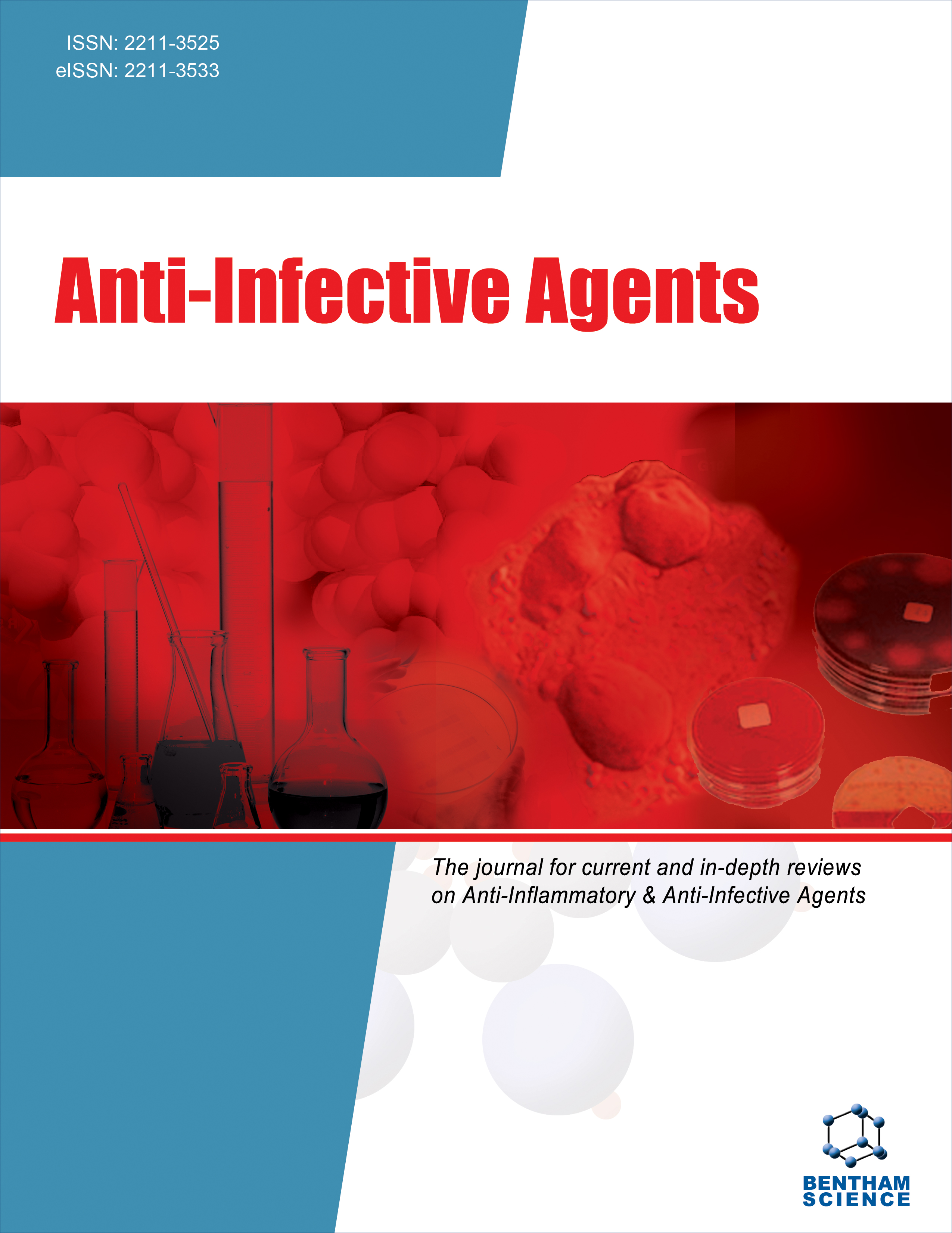- Home
- A-Z Publications
- Anti-Infective Agents
- Previous Issues
- Volume 22, Issue 4, 2024
Anti-Infective Agents - Volume 22, Issue 4, 2024
Volume 22, Issue 4, 2024
-
-
The Battle against Diphtheria: Nigeria's Ongoing Struggle
More LessAuthors: Brajesh K. Panda, Diksha, Animesh Ranjan and Amandeep SinghCorynebacterium diphtheriae is a Gram-positive, rod-shaped, nonmotile bacillus. Lysogenic strains carry the diphtheria toxin gene (tox) on corynebacteriophages. It's categorized into biotypes and lysotypes based on colony morphology and phage sensitivity. The disease involves the upper respiratory tract, causing symptoms like fever and painful throat, with severe cases forming airway-blocking pseudomembranes [ Read More
-
-
-
Pyolytics: A Step Forward to Address Respiratory Hypoxia in Coronavirus Infection
More LessAuthors: Ilnur Yagudin and Darya SuntsovaRespiratory failure and increasing hypoxia in the era of coronavirus infection is the cause of fatal outcomes in patients with SARS. The bronchoalveolar obstruction prevents the normal passage of air, resulting in decreased oxygenation. The available methods of oxygenation (ECMO) are often not cost-effective and are not readily available in pandemic settings. Hence, the search for alternatives has prompted the disc Read More
-
-
-
Health Policy Analysis on the Containment of Antimicrobial Resistance (AMR) in India: A Mixed Methods Study of Antimicrobial Stewardship as a Pivotal Intervention in Tackling AMR
More LessAuthors: Chetan Singh, Anita Pandey and Lubhan SinghObjective: This policy report aimed at two goals, that is, to report the findings of the literature review and explore the perceptions of the key stakeholders in seeking better insight into the antimicrobial stewardship program (AMSP), and to develop antimicrobial resistance (AMR) policy recommendations for the Ministry of Health and Family Welfare (MoHFW), India, based on the findings from the rapid systematic review Read More
-
-
-
Antimicrobial Stewardship: Smart Approach to Combat Antibiotic Resistance
More LessAntimicrobial resistance (AMR) is a major public health concern worldwide. It raises morbidity and mortality and is connected with substantial/significant economic costs. Effective prevention and treatment of an increasing number of diseases caused by pathogens that can no longer be treated with conventional drugs are threatened by antimicrobial resistance. AMS programme helps to encourage the appropri Read More
-
-
-
Therapeutic Potential and Pharmacological Activities of Bioflavonoid ‘Ochnaflavone’ in Medicine: Diverse Scaffolds and Promise Leads for Drug Discovery
More LessAuthors: Kanika Patel and Dinesh Kumar PatelBackground: Biflavonoids are natural phytocompounds that received enormous attention in various remedies due to their diverse biological activities. Biflavonoids have antiinflammatory, anti-leishmanial, anti-plasmodial, anti-viral and β-secretase inhibitory activity in medicine. Ochnaflavone is a biflavone class natural phytochemical isolated from plants belonging to the Ochnaceae family. Methods: Scientific info Read More
-
-
-
Hierarchical Virtual Screening of SARS-CoV-2 Main Protease Potential Inhibitors: Similarity Search, Pharmacophore Modeling, and Molecular Docking Study
More LessAuthors: Huda Mando and Iyad AllousBackground: The outbreak of COVID-19 caused by severe acute respiratory syndrome coronavirus2 (SARS-CoV-2) resulted in a widespread pandemic. Various approaches involved the repositioning of antiviral remedies and other medications. Several therapies, including oral antiviral treatments, represent some approaches to adapting to the long existence of the COVID-19 pandemic. In silico studies provide valuable i Read More
-
-
-
Antimicrobial and Antifungal Effects of Essential Oils from Origanum vulgare, Lavandula officinalis, and Syzygium aromaticum on Bacterial Strains through Gaseous Contact
More LessAuthors: Nabila Ainseba, Nabila Loukili, Amina Soulimane, Samia Bellifa, Mohammed E. A. Dib and Alain MuselliBackground: Hospital-acquired infections, also known as nosocomial infections, affect thousands of patients worldwide. In Algeria, these infections raise significant concerns and give rise to numerous questions due to hygiene deficits and non-compliance with preventive measures. Objective: The main objective of this study was to investigate the antibacterial and antifungal properties of Origanum vulgare, Lavandula officinalis, Read More
-
-
-
Evidence of Neutralizing Antibodies Indicating the Cure of Patients Infected with COVID-19 Within one Month of Infection
More LessBackground: During COVID-19 pandemic a major conflict facing the clinician where to prove cure of the patients. Aims: The idea of confirming curability is based on clinical evaluation of the symptoms, laboratory investigations, and specific IgM, IgG anti-SARS-CoV-2 antibodies. Materials and Methods: All patients had presented with clinical features of COVID-19 positive PCR attended private clinic doctors consultant in internal Read More
-
-
-
In vitro Ascertainment of Interactions between Kanamycin and Adjuvants against Various Bacterial Species
More LessAuthors: Namita Sharma and Anil K. ChhillarBackground: In recent times, there has been incontrovertible evidence regarding the propensity of various bacteria that barge through the immune system of an already debilitated individual. In this regard, combination therapy presents us with a more effective approach than conventional monotherapy. A specific combination of antibiotics exhibits a synergistic antibacterial effect, which can be seen with kanamycin, which s Read More
-
-
-
Molecular Characteristics of Cephalosporin Resistant Escherichia coli and Klebsiella pneumoniae Isolated from Children in a Tertiary Care Centre of Central Kerala, India
More LessAuthors: Santhosh J Thattil, Suresh Dhanaraj and Thekkuttuparambil A AjithAims: The study was aimed to determine the molecular characteristics of extendedspectrum beta-lactamases (ESBL) producing cephalosporin-resistant Escherichia coli and Klebsiella pneumoniae isolated from children below ten years of age. Background: Geographically diverse variations in the prevalence of ESBL genes were reported. No data were available on the prevalence of ESBL genes in central Kerala, India, among Read More
-
Most Read This Month
Article
content/journals/aia
Journal
10
5
false
en


